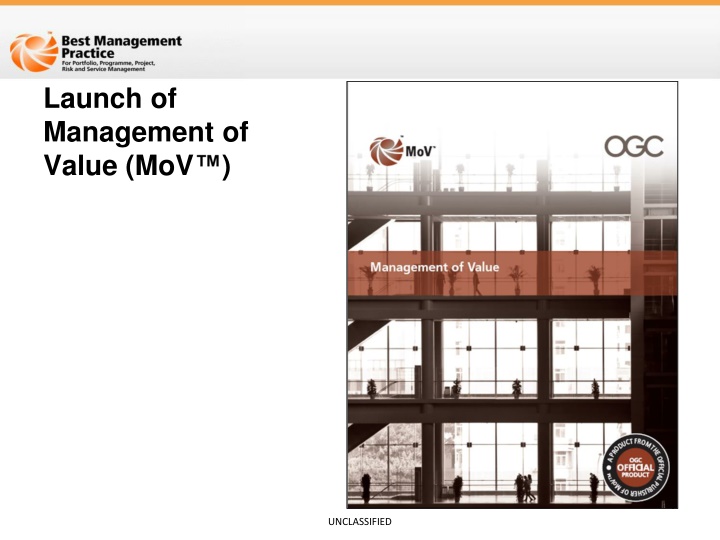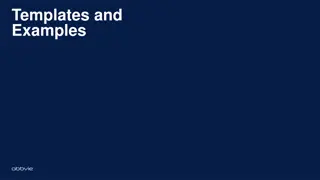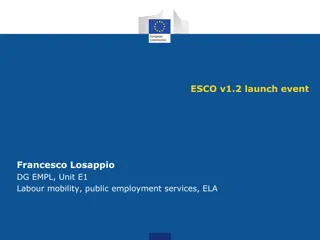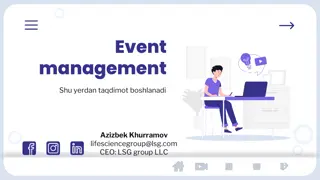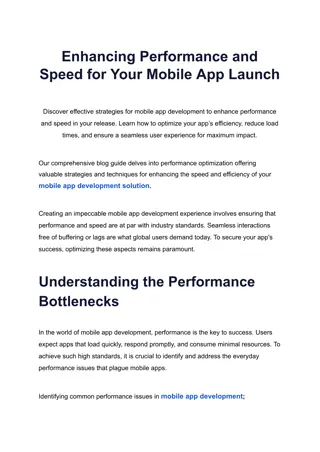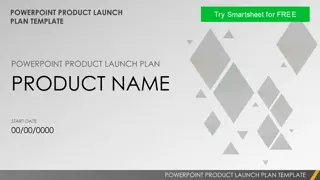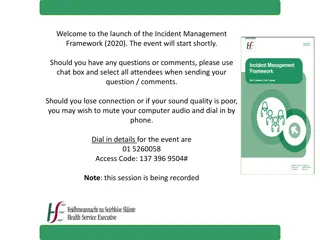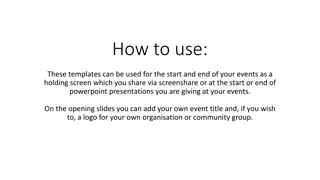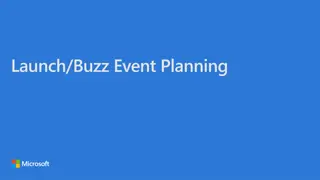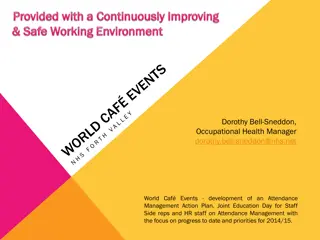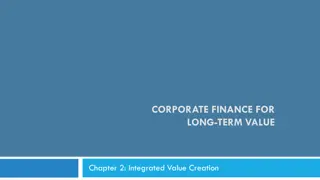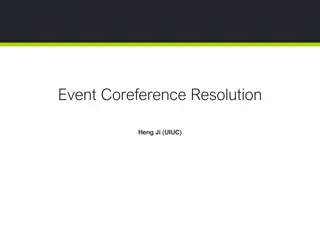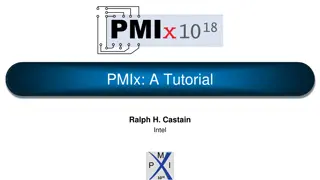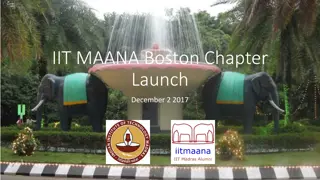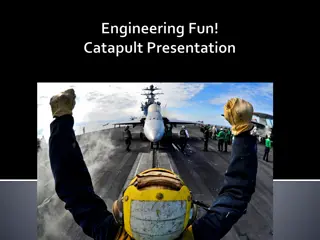Enhancing Value Management with MoV Launch Event
Explore the launch event of Management of Value (MoV), featuring insightful presentations on the importance of MoV, its impact on competitiveness, productivity, and profitability, and how it maximizes return on investments. Learn how MoV fills a crucial gap in PPM publications and provides a framework for delivering value across various sectors.
Download Presentation

Please find below an Image/Link to download the presentation.
The content on the website is provided AS IS for your information and personal use only. It may not be sold, licensed, or shared on other websites without obtaining consent from the author.If you encounter any issues during the download, it is possible that the publisher has removed the file from their server.
You are allowed to download the files provided on this website for personal or commercial use, subject to the condition that they are used lawfully. All files are the property of their respective owners.
The content on the website is provided AS IS for your information and personal use only. It may not be sold, licensed, or shared on other websites without obtaining consent from the author.
E N D
Presentation Transcript
Launch of Management of Value (MoV ) 1 UNCLASSIFIED
Agenda Opening comments and domestics Introduction by David Pitchford Overview briefing Michael Dallas Institute of Value Management perspective Michael Graham Q&A Extended question time and networking 2 UNCLASSIFIED
Introduction David Pitchford Executive Director Major Projects Directorate Cabinet Office 3 UNCLASSIFIED
Overview of Management of Value (MoV) Michael Dallas MA (Cantab), MICE, FIVM, MAPM Director APM Group Ltd 4 UNCLASSIFIED
Why? Feasibility study 2008 confirmed a gap in the PPM suite of publications No publications available that cover application at Portfolio, Programme, Project and Operational levels in Public and Private sectors Enhances many of the methods available in other publications such as PRINCE2 and MSP 5 UNCLASSIFIED
Why MoV? MoV enhances competitiveness, productivity and profitability Maximising return on investments Making optimum use of resources Providing value for money for customers Streamlining production and delivery of services Eliminating wasteful practices It also provides a way to Deliver cost savings with minimum impact on essential quality of products and services Cut non essential projects or services 6 UNCLASSIFIED
We (must) move to taking the decisions necessary to equip Britain for long-term success. That means prioritizing things like better schools and infrastructure improvements so that we can build a sustainable economy for the future. The Rt. Hon David Cameron, August 2010 7 UNCLASSIFIED
Context Complements other Best Management Practice products 8 UNCLASSIFIED
How does MoV maximise Value? Value defined as ratio between satisfaction of needs (benefits) and use of resources (expenditure) Reconciling the needs and views of different stakeholders Balancing the use of resources to suit priorities Balancing the overall benefits realised with the use of resources by optimising the value for money ratio 9 UNCLASSIFIED
Where and when should I use it? MoV is applicable to hard and soft projects in all sectors More opportunities early in project lifecycle 10 UNCLASSIFIED
MoV Principles Based on seven sound principles 1. Align with organisational objectives 2. Focus on functions and required outcomes 3. Balance the variables to maximise value 4. Apply throughout the investment decision 5. Tailor to suit the subject 6. Learn from experience and improve 7. Assign clear roles and responsibilities and build a supportive culture 11 UNCLASSIFIED
MoV Processes Underpinned by seven fundamental processes 1. Frame the programme or project. 2. Gather information 3. Analyse information 4. Process information 5. Evaluate and select 6. Develop Value Improving Proposals 7. Implement and share outputs 12 UNCLASSIFIED
The value cascade Relates products and objectives to organizational goals 13 UNCLASSIFIED
Key techniques MoV Specific Function Analysis is a key technique of MoV Analyses what things do rather than what they are Defers seeking improvement until functions are visibly mapped Opens the door to innovative value improving proposals Two main approaches: Function Analysis System Technique (FAST) Value Trees Both use How/Why logic 14 UNCLASSIFIED
A customer FAST diagram Shows the relationship of functions and their hierarchy 15 UNCLASSIFIED
A Value Tree Defines value drivers Shows what designs need to address Informs the brief 16 UNCLASSIFIED
A Value Profile Articulates an organization s or stakeholders priorities 17 UNCLASSIFIED
A Value Index Indicates how well a project satisfies an organization s or key stakeholders needs Does not indicate value for money 18 UNCLASSIFIED
The Value Ratio Demonstrates Value for Money 19 UNCLASSIFIED
Value Engineering Value engineering (VE) is a method that brings many of the above processes together into one coordinated study. It remains the most commonly used method within the MoV family 20 UNCLASSIFIED
Techniques commonly used in MoV Apply to and reflect the MoV Processes Analysing information Generating innovative ideas Selecting options Evaluating the merits of and selecting ideas Building decisions to implement Value Improving Proposals Implementing VIPs and realising benefits Linked to descriptions of these and other techniques may be found at the TSO On Line Repository for MoV at: http://www.best-managementpractice.com 21 UNCLASSIFIED
Approach to implementation Explains the purpose of following the processes Sets out a generic approach around which to structure a MoV Study 22 UNCLASSIFIED
Relationships Possible relationship between Project management and an Organization s management 23 UNCLASSIFIED
Interacting with the environment 24 UNCLASSIFIED
Embedding into an organization Possible Organizational management structure Must be proportionate to the need 25 UNCLASSIFIED
Appendices 26 UNCLASSIFIED
Executive Guide to Value Management To inspire senior management to adopt and use MoV 27 UNCLASSIFIED
Foundation level qualification Management of Value Foundation Exam Syllabus 16 October 2010 UNCLASSIFIED Available to ATOs from today 28
Some challenges ahead But, when the cancellation of entire programmes is needed, deciding what to cut is often far from scientific Cutting costs arbitrarily is easy. It is less easy is to cut costs in a way that will safeguard the long term economic recovery In total, the government is looking for 1.7bn savings from delaying and stopping projects The toughest public spending cuts in a generation There is a 30% affordability gap 29 UNCLASSIFIED
and some successes in the past A study into the development of an international-class sports stadium involved a team of about 20 people for a month . The overall reduction in costs in the accepted value-improving proposals was US$200 m, representing a return on the total cost of the study of 333:1. Value Management helped a hospital to recognize that its pharmacy s function was not so much dispensing drugs as managing medication . This was relevant to the whole hospital, not only the pharmacy. Whereas the pharmacy cost around 2 m per year to run, it influenced broader hospital costs of around 19 m, enabling far greater savings. And many more in the guide... 30 UNCLASSIFIED
Conclusion In short, MoV provides a unique, proven and economical way to maximise value for organisations across portfolios, programmes, projects and operations 31 UNCLASSIFIED
IVM Perspective Michael Graham Chair of the Institute of Value Management Certification Board 32 UNCLASSIFIED
Q&A SESSION 33 UNCLASSIFIED
EXTENDED QUESTION TIME 34 UNCLASSIFIED
